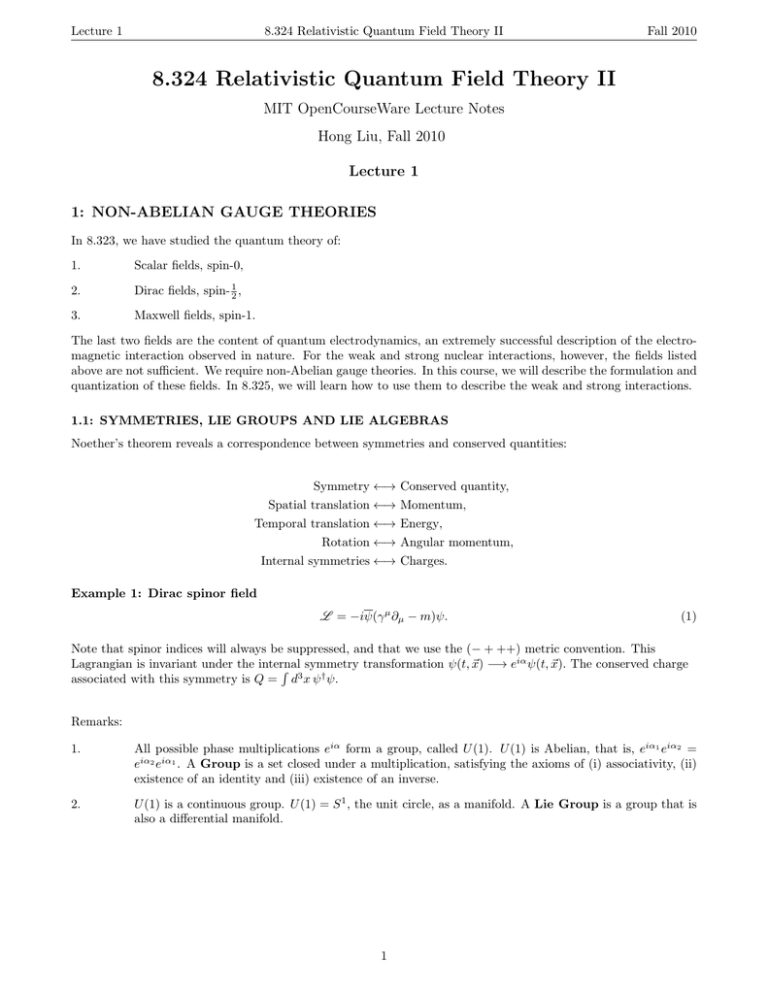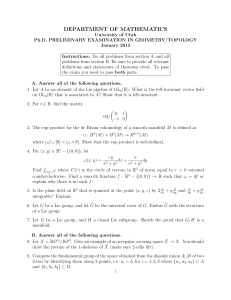Document 13650470
advertisement

Lecture 1 8.324 Relativistic Quantum Field Theory II Fall 2010 8.324 Relativistic Quantum Field Theory II MIT OpenCourseWare Lecture Notes Hong Liu, Fall 2010 Lecture 1 1: NON-ABELIAN GAUGE THEORIES In 8.323, we have studied the quantum theory of: 1. Scalar fields, spin-0, 2. Dirac fields, spin- 12 , 3. Maxwell fields, spin-1. The last two fields are the content of quantum electrodynamics, an extremely successful description of the electro­ magnetic interaction observed in nature. For the weak and strong nuclear interactions, however, the fields listed above are not sufficient. We require non-Abelian gauge theories. In this course, we will describe the formulation and quantization of these fields. In 8.325, we will learn how to use them to describe the weak and strong interactions. 1.1: SYMMETRIES, LIE GROUPS AND LIE ALGEBRAS Noether’s theorem reveals a correspondence between symmetries and conserved quantities: Symmetry ←→ Conserved quantity, Spatial translation ←→ Momentum, Temporal translation ←→ Energy, Rotation ←→ Angular momentum, Internal symmetries ←→ Charges. Example 1: Dirac spinor field L = −iψ(γ µ ∂µ − m)ψ. (1) Note that spinor indices will always be suppressed, and that we use the (− + ++) metric convention. This Lagrangian is invariant under the internal transformation ψ(t, ⃗x) −→ ei� ψ(t, ⃗x). The conserved charge ´ 3 symmetry † associated with this symmetry is Q = d x ψ ψ. Remarks: 1. All possible phase multiplications ei� form a group, called U (1). U (1) is Abelian, that is, ei�1 ei�2 = ei�2 ei�1 . A Group is a set closed under a multiplication, satisfying the axioms of (i) associativity, (ii) existence of an identity and (iii) existence of an inverse. 2. U (1) is a continuous group. U (1) = S 1 , the unit circle, as a manifold. A Lie Group is a group that is also a differential manifold. 1 Lecture 1 8.324 Relativistic Quantum Field Theory II Fall 2010 eiα α 1 Figure 1: U (1) as the manifold S 1 with the elements 1 and ei� shown explicitly. Example 2: Two Dirac fields L = −iψ 1 (γ µ ∂µ − m1 )ψ1 − iψ 2 (γ µ ∂µ − m2 )ψ2 . (2) This Lagrangian is invariant under the internal symmetry transformations U (1) : ψ1 (x) −→ ei�1 ψ1 (x), U (1) : ψ2 (x) −→ ei�2 ψ2 (x). (3) The group formed by this set of transformations is U (1) × U (1), with distinct charges of(ψ1 )and ψ2 . If ( ) 1 ¯ m1 = m2 = m, there is a larger symmetry, since we can mix ψ1 and ψ2 . Introduce Ψ = � �2 , Ψ = ψ 1 ψ 2 . We can then rewrite (2) as L = −iΨ(γ µ ∂µ − m)Ψ, (4) which is invariant under the internal symmetry transformation † ¯ ¯ U (2) : Ψ(x) −→ U�(x), Ψ(x) −→ �(x)U , where U is a 2 × 2 matrix such that UU† = 1. (5) (6) The complex matrices satisfying this condition form the group U (2). We can separate out an overall phase rotation in these transformations: Ψ(x) −→ ei� Ψ(x) (7) where U = ei� =ei� �2×2 . We can constrain the residual transformation U′ to satisfy det U′ = 1. (8) The set of 2 × 2 matrices satisfying (6) and (8) form the group SU (2). In summary, for m1 = m2 , (2) is invariant under U (2) = SU (2) × U (1) (9) where U (1) is proportional to the identity matrix and commutes with SU (2). Remarks: 1. SU (2) is a non-Abelian group. U1 U2 ̸= U2 U1 . It has three continuous parameters (diffeomorphic as a manifold to S 3 ). 2 Lecture 1 2. 8.324 Relativistic Quantum Field Theory II Fall 2010 [ ] Any SU (2) group element can be written as U = exp iΛa �2a , with Λa constant, a =1, 2, 3. σa here are the Pauli matrices, and �2a are the generators of SU (2), satisfying the associated su(2) Lie algebra commutation relations, [σ σ ] σc a b , = iϵabc . (10) 2 2 2 3. For infinitesimal Λa , U =1+iΛa �2a + . . ., we have that δΨ = iΛa �2a Ψ, and by Noether’s prescription, we find an associated set of conserved charges Qa , (a = 1, 2, 3), which satisfy the commutation relations [Qa , Qb ] = iϵabc Qc (see problem set). That is, the conserved charges satisfy the Lie algebra commutation relations. 4. Starting with n Dirac fields of the same mass, we find the symmetry group U (n) = SU (n) × U (1), where U (n) is the set of n × n matrices under matrix multiplication that satisfy UU† = U† U = 1. SU (n) and U (n) are examples of Lie groups. 1.1.2. More information on Lie groups and Lie algebras (for a more detailed treatment, the reader is referred to the notes by B. Zweibach, Peskin and Schroeder, §15.4, and Weinberg, Volume I, p53-55, Volume II, §15.1-15.2.): a. c. b. Λa Figure 2: a. U (1), the manifold S 1 . b. SU (2), the manifold S 3 (one dimension suppressed). c. An arbitrary manifold with a point Λa labelled. Lie group: a continuous group that is also a differential manifold. Examples include U (1), which is the manifold S 1 , and SU (2), which is the manifold S 3 . The group elements are labelled g(Λa ) ∈ G, where Λa are parameters labelling points of the manifold, a = 1, 2, . . . , dim G. They satisfy a group multiplication: where g(Λ) ◦ g(Λ′ ) = g(Λ′′ ), (11) Λa′′ = fa (Λ, Λ′ ). (12) Lie groups are tailor-made for describing continuous symmetry transformations in physics: the group product corresponds to the composition of transformations. The group product satisfies the properties of (i) closure, (ii) associativity, (iii) existence of an inverse element, and (iv) existence of an identity element. Now consider a system described by some Lagrangian, L . All physical symmetric transformations form Lie groups. Examples include: � 1,3 - space-time translations, SO(1, 3) - Lorentz boosts and rotations, U (n) - internal symmetry groups. A compact Lie group is a manifold of finite volume. 3 Lecture 1 8.324 Relativistic Quantum Field Theory II Fall 2010 1 Figure 3: A Lie algebra as the elements in the infinitesimal vicinity of the group identity element. Lie algebra: as physicists, we are often interested in infinitesimal transformations, in order to find the conserved currents. As mathematicians, describing the general structure of a Lie group is difficult. The trick is to consider elements of G that differ infinitesimally from the identity element, from which one may build up the entire group. Choose Λa so that g(Λa = 0) = 1. Then g(ϵa ) = 1 + iϵa T a + O(ϵ2 ), (13) where a = 1, . . . , dim G. It is a physicist’s convention to extract a factor of i explicitly in the expansion, so that the generators are hermitian for unitary group transformations. ϵa parameterizes the tangent space around g = 1, with T a a basis for the tangent space. Mathematically, ϵa T a ∈ T1 G. Putting (12) into (13), we find T a should satisfy [ a b] T , T = if cab T c , (14) [ a b] where T , T ≡ T a ◦ T b − T b ◦ T a , defining the Lie algebra g associated with the Lie group G. The f cab are the structure constants of the Lie algebra and are necessarily anti-symmetric [ in a,] b. There is another constraint on the structure constants: as the group multiplication, ◦, is associative, T a , T b satisfies the Jacobi identity: [[ a b ] c ] [[ b c ] a ] [ c a ] T , T , T + T , T , T + [T , T ] , T b = 0. (15) f dab f edc + f dca f edb + f dbc f eda = 0. (16) Hence, 4 MIT OpenCourseWare http://ocw.mit.edu 8.324 Relativistic Quantum Field Theory II Fall 2010 For information about citing these materials or our Terms of Use, visit: http://ocw.mit.edu/terms.


